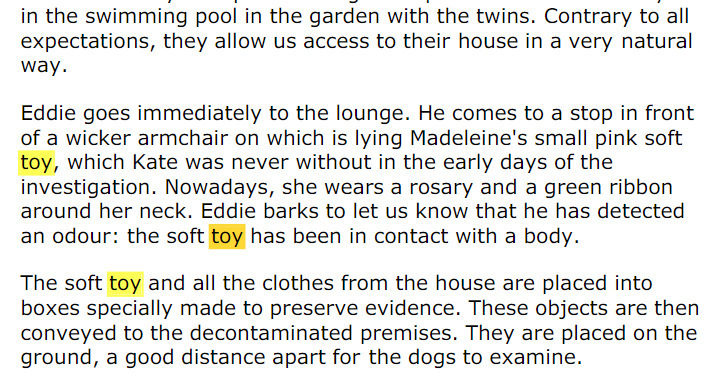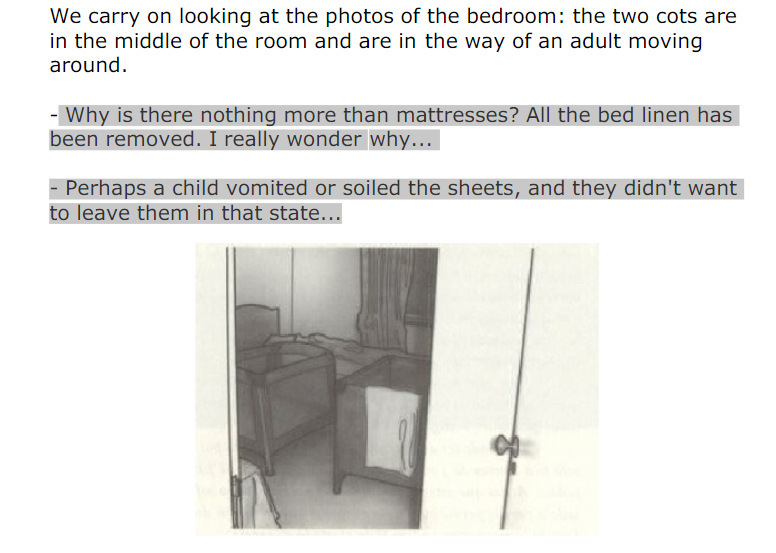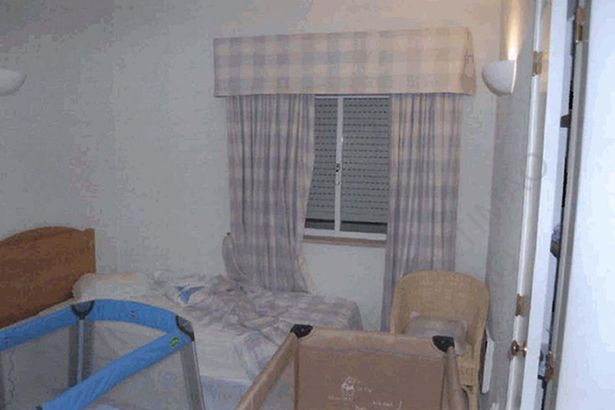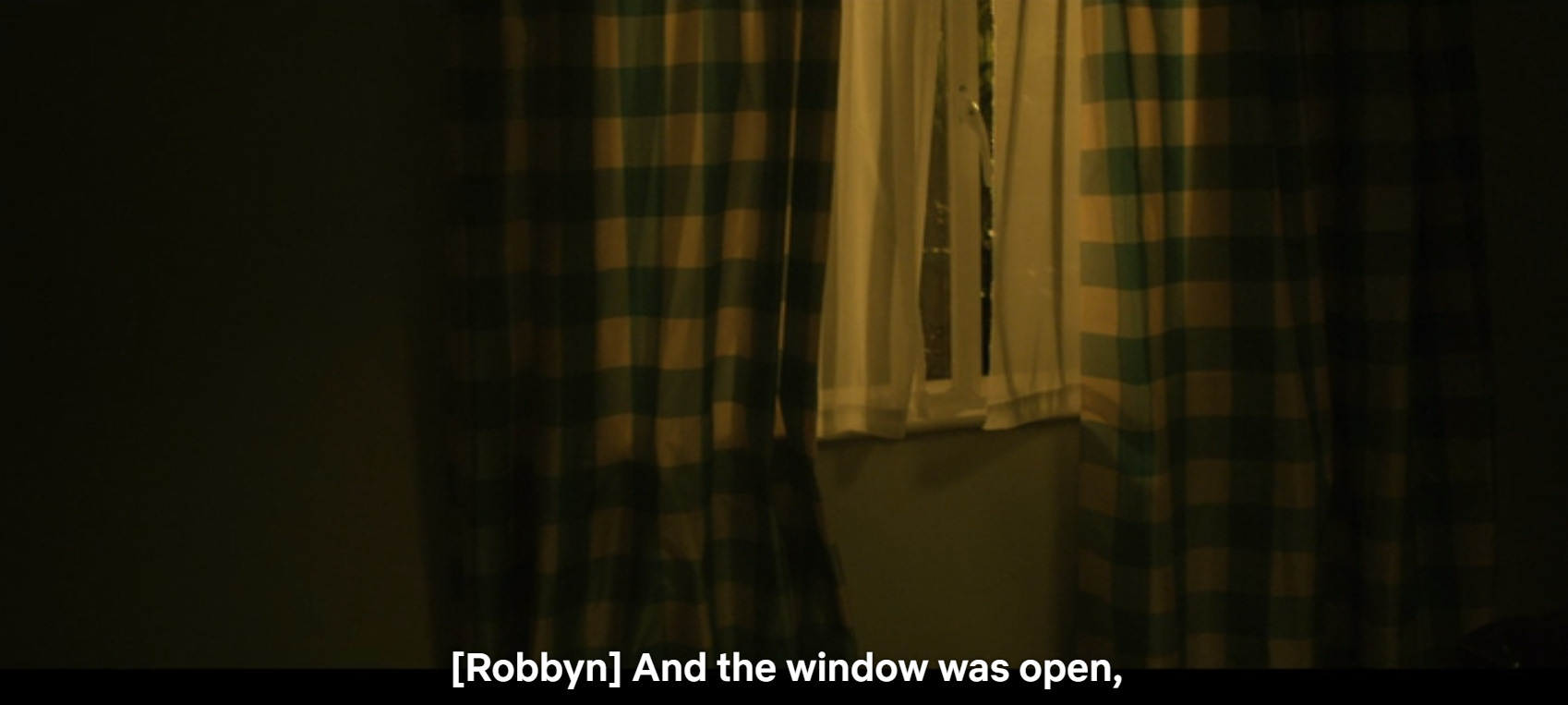The final episode of the series kicks off by boomeranging back to Robert Murat, the first suspect the series itself fixed in its crosshairs. But in the final episode, Murat is no longer sketched as a prime candidate for the pedophile or trafficker moniker, now it’s poor Robert Murat.
The series seems to have covered a kind of full circle. Murat’s no longer portrayed as a suspect, but as a victim. it’s brilliant mindfuck for what’s to follow. Because this sympathetic twist is also an analogy for the McCanns themselves [nudge nudge, wink wink] as wholly innocent victims, isn’t it?
The docuseries strikes a much more sympathetic tone as it winds down now, basically taking the view that one of the major villains of the story – besides Amaral – is the media. See, the media have condemned and falsely judged Murat, and coincidentally the McCanns as well. See, the media have perpetrated a terrible injustice on an innocent man, just as they have on a wonderful, loving, innocent couple.
Really?



When the opening credits roll, Jim Gamble [we really need to talk about him at some point too, because he’s another Arch Apologist for the McCanns] does a handy voice-over about hope.


I want to address the aspect of hope that is such a crucial element of the McCann mythos, and the key dynamic driving their PR narrative. Essentially it is a narrative of hope.
In the past I’ve cited the idea that rebellions are built on hope, but I suspect it’s fallen on deaf ears. It sounds nice. It sounds catchy. But what does it mean? It really requires explication. I’ll do that at the end of this post, so put that thought in your back pocket for now [and give it a little tap]. We’ll attend to it later.
The main theme of episode eight is explicitly built around the notion of hope, and incidentally, it’s the subtext to the entire series as well, even though it pretends to be neutral, investigative, emergentivistic as opposed to reductionist.
But it is reductionist.
Whether Madeleine was abducted by pedophiles, an orphanage, a travelling salesman, a gypsy, a gang of thieves or Santa Claus [don’t laugh, this was seriously presented as one of infinite suspects in the Ramsey case] any and every abduction scenario is a scenario that Madeleine is still alive, and thus this is “just” a missing person case. In other words, “there is still hope”.
As soon as the other narrative is acknowledged, then it’s not merely that Madeleine is dead, but almost automatic that her parents, and perhaps others are involved in some more or less nefarious plot. Are they? Could they be? Or is there some other explanation?
Did Madeleine fall into a construction site? Curiously it’s the contention of detective Amaral that Madeleine may have accidentally fallen to her death [for example falling on the floor behind the blue sofa] inside apartment 5A, so the “fallen” notion isn’t absurd.
But consider how contrary the atavistic “fallen” notion is to the more progessive and thus sophisticated “hope” plot. And so, for as long as the abduction narrative is popular, and acceptable, and while the narrative that “there is no evidence that Madeleine is dead” continues to hold, the parents – and others – will remain above suspicion and implicitly beyond reproach. That’s not rocket science. We know this.



Episode eight is titled “Somebody knows”, which is to say a) somebody out there knows what happened to Madeleine [who is alive] and b) that somebody is not Kate or Gerry McCann or any of the Tapas 7. It’s not Goncalo Amaral either but some anonymous other person. And then there is c) if Madeleine herself is alive, apparently she doesn’t know who she is either and someone [the someone who knows] needs to tell her, or tell someone.
See, it’s a very hopeful episode. It’s positive. But is it realistic? It feels more than a tad reductionist, doesn’t it?If there’s no evidence that Madeleine is dead, does that mean she’s alive? If no one has seen her for twelve years, does that mean she’s alive? What about twenty years?
At what point does the passage of time actually enter the equation [besides the other crime scene related data]? After fifty years? How about sixty? And how are these time scales related to other missing person cases? Do we normally consider someone alive when they disappear for thirty, fourty, fifty years? If the law decides on this aspect [and it does] what sort of legal narrative are we actually taking about then, if we say there is “no evidence” to say she’s dead? Is there any evidence to say she’s alive?
To the casual observer, and even the not-so-casual observer, the hope narrative is both compelling and convincing. There is even an official inquiry condemning adverse media coverage of the McCanns [notably the the British media] as unethical and poor journalism. Since the media have been accused of this before, it’s easy to imagine they crossed this line with the McCanns, and clearly they did. The question is, how egregious was the inaccuracy? Was it completely baseless or was it somewhat baseless? Or…something else?
What this comes down to, ultimately, is what is truth? And what is the truth in this case? In one sense there is the objective truth [which is in a sense unknowable], and then there is the legal truth [which is what society’s “official” position is on truth]. A useful way to illustrate how potentially irreconcilable objective and legal truth can be, take religious belief. Is it objectively true? Some science, if not most, will say no. Is it legally true? Well, it depends on which country you are. In Saudi Arabia some “beliefs” are legally enforceable but not necessarily legal, and certainly not elsewhere.
The fact is, the legal position of the McCann case is that Madeleine isn’t dead, or rather, there is no evidence to prove that she’s dead. We’ll leave the argument for the moment that there is no evidence proving she’s alive either. In this respect, any publication claiming as fact or as potentially factual that Madeline is dead runs foul of legal fact, but not necessarily of objective fact. Does that make sense? So from a legal perspective, certainly the media are constricted in making certain claims, even if certain circumstantial and other evidence supports their claims.









And publishing Kate’s diary, apparently without her permission, does look bad in the context of this inquiry. On the other hand, Kate wrote a book in meticulous detail which was serialized in the papers, and her diary formed part of that narrative. So the notion that Kate’s interior world was violated feels a little less fraught than the way Kate frames. It may not be, but if we’re talking about the contents of a diary being published as a violation, and then one elects to do the same, well, isn’t one violating oneself?



It should also be noted that the diary was confiscated as evidence, and in many instances, diaries are used cynically by murder suspects to present a false narrative. Jodi Arias famously lied to her diary, which was discussed and analysed at length during her criminal trial. Amanda Knox kept a diary too which she quoted at length in her own self-justifying book.
Now if News of the World committed despicable act by “stealing” Kate’s diary, one could also argue that the same newspaper handed the McCanns a princely sum [£125,000] which went into the Find Madeleine Fund, which is to say, went by hook or by crook to the McCanns and the directors of the fund. The Sun serialised Kate’s book which was a major PR boost for the book, and deal probably worth millions. Let’s not forget it was the newspapers who also raised massive public awareness for the McCanns, including publicising the fundraising on their behalf [with their own readers], and making it known to the “abductor” that massive rewards were in the offing.
It seems impossible to imagine that if Madeleine was abducted, her abductor was not aware of the enormous reward offered for her safe return. Well, apparently it wasn’t enormous enough.

What you won’t find in the British press is what happened to the reward money [since no one came forward to claim it]. News of the World gave the McCanns £1.5 million reward money to the Find Madeleine Fund. Apparently when Gerry McCann was asked about whether he or the Fund had received the money, he referred to the questioner to ask the publisher, and suggested that the reward money wasn’t actual money but pledges.
Interestingly, in 2018 the McCanns tried to revive the Leveson inquiry, but this time the inquiry had other fish to fry. The Netflix documentary is silent on this recent failure, however.
Clearly the Leveson Inquiry needs to be seen in proper context given the myriad ways the McCanns benefited from British media coverage and publicity, and some may be so bold to say profited [or that their Fund made a colossal fortune out of it, at least for as long as the coverage was positive…which incidentally includes up to the present moment.] The point is, from a distance, a pair of well-to-do doctors appealing to the media for better treatment appears well-to-do in general, and to the casual observer, and the not-so-casual observer, this step appears to confirm their overall credibility in terms of this case.
But there’s more.
The McCanns took their cause even further and demanded British government intervention – to investigate the disappearance of their daughter. Now I know what you’re thinking. It stretches the credibility of a cover-up to breaking point – doesn’t it – to have the suspects demand an investigation into their case. It may seem that way, and clearly the folks in this particular true crime case are smarter than the average, but the Ramseys made similar appeals to powerful political figures. Ramsey himself ran for election twice. We must remember that these appeals for further investigation were conducted with the express proviso that the investigation be steered in a particular direction [away from the Ramseys as suspects].
It’s also vastly under-reported that Ramsey himself was affiliated with Lockheed Martin, in fact he was a vice president, and thus the death of a little girl actually presented a case for a potential risk or undermining of national security. I know that sounds outlandish, but only until one looks at the size of the MegaMachine that is Lockheed Martin, and its strategic importance to the security of the State it serves.







With the McCanns we see similar state-level interventions. 2007 was the year Britain joined the European Union. Guess where the political meeting took place that year? Lisbon. Guess when? October 2007. When was Amaral fired as a result of political pressure from Britain? The same month.

If one considers a criminal case which has the potential to affect diplomatic relations between two countries, then there are at least two possible scenarios. One scenario is that the suspects are guilty and because there is no prosecution or perception of justice, this can lead to enmity not only towards the suspects, but between the two nations.
In the McCanns case Portugal resented the way it was being depicted in the media, and referred to the British media and the British police treating it like it might a colonial power. This was clearly neither good PR nor politically expedient at a time when Britain wanted to – sort of – and Portugal wanted them – sort of – to belong to the European Union. The solution to problem – certainly one solution – was to make the case go away. By giving the public what they wanted [which was Madeleine to be alive, and the McCanns to be innocent] one could theoretically diffuse a political sensitive time-bomb. And the man the British government appointed to make sure the McCann case went where it needed to go was a man with the appropriately titled surname Gamble.




Gamble happens to be one of the primary narrators of the Netflix docuseries. He’s the man tasked by the British government with “sorting out” the McCann case. And Gamble has elected to sort out the case by publicly putting his weight behind. And he’s very public. He’s very much in the media and in documentaries.
Why top Maddie cop is convinced McCanns in the clear – MSN
Who is Jim Gamble and what claims does he make in Netflix doc the Disappearance of Madeleine McCann? – Heart
Another prominent narrator is Kelvin MacKenzie, an editor of The Sun who – in episode eight – reveals that “not for a single second” did he believe the McCanns “have ever had anything to do with” Madeleine McCann’s disappearance. He has no doubt the McCanns are innocent. Well why not say so right in the beginning, sir? And why is an editor of The Sun between 1981 and 1994, thirteen years before the publicity of the case started, being asked to share his opinion on how the media treated them?




Well, so much for political expedience, and politically inexpedient court cases. Ten years later Brexit is happening anyway.
The best way to make a criminal case go away is to make sure it never goes to trial. But they didn’t count on the lead detective writing a book, or being sued, or him countersueing and appealing. That has been a long process and hasn’t helped the cause of the McCanns, the Metropolitan police, the British media or the British government. Or even the Portuguese government.
There is another half-hour of analysis to get through in the final episode of the series, but this blog is getting book chapter length and I see it’s 01:37. So let’s wrap up.
I mentioned early on in this post about the idea that rebellions are built with hope, and I said to put that idea in the back pocket. Let’s look at it now.
The idea of a rebellion built on hope is perfectly appropriate to the McCann case, at least in my view. The rebellion is arguably a rebellion against fear [fear of death] which is in some ways admirable, positive and constructive. But one might also argue that this rebellion isn’t just a touchy feely belief, but that in spite of claims of “no evidence” that Madeleine is dead, actually it looks like there might be some evidence. If it’s stronger than that, than the rebellion isn’t just against fear, it’s potentially against common sense, against reality, even perhaps against a legal system. We know the case is being debated and evaluated at the European Court of Human Rights. That court will decide whether the notion that Madeleine McCann is dead or alive – either way – is frivolous. It’s interesting because now Britain as a member of the European Union has sort of fallen out of favour with the EU, and not due to any fault of the EU.
What we can also say is that plenty of pageantry surrounds the McCann case. It’s not simply a case where we see investigations and police searches. We also see the couple meeting the Pope and releasing balloons, and suing people. A lot of people.





We see book deals, book launches, color coded wrist bands, hundreds of exclusive interviews [invariably written by the same journalists], dozens of documentaries, innumerable anniversaries and celebrations [Madeleine’s birthday, commemorating her disappearance], and of course, the revolving door of PR personnel who plead the McCann’s case to a salivating press – who in turn regurgitate these statements almost verbatim. That kind of pageantry.
The pageantry isn’t a foreign concept to Britain. The notion of Royalty in the modern era, and the royal family is fairly idiosyncratic to Britain, and arguably the most British aspect of the nation. One could also say that the pageantry of the British Royal family is more public and more publicised than royalty in any other country bar none. So let’s not kid ourselves when we say pageantry can be a very popular, powerful and profitable tactic.
But how much of this pageantry is really just a rebellion against a more pragmatic and realistic approach. Pageantry is bright, colourful but above all hopeful.
A final word on misleading media coverage – or at least what I thought was misleading – published in The Sun. This graphic. Notice anything wrong with it?

The graphic shows where the “last photo” of Madeleine McCann was taken. This photo is almost certainly fake, and appears to be doctored, its metadata altered so that the photo is dated May 3rd.
What to make of the “Last Photo” of Madeleine McCann?
Proof! The ‘Last Photo’ is Fake
The indicator for where the Tapas Bar is on the graphic [right below the McCanns’ apartment] is misleading and incorrect. The Tapas Bar is way to the left, closer to the centre of the image.
In the next frame, the dogs didn’t alert to the sofa, they alerted to blood and cadaver evidence on the floor and walls behind the sofa.
Kate and Gerry’s beds were two single beds pushed together, but the graphic doesn’t indicate that both beds were pushed a long way away from the wardrobe, far enough to fit in the cots of the twins.
The same image makes no mention of cadaver traces found in the McCanns cupboard, nor of those found outside in the garden below the balcony.
The graphic suggests the door to the parking lot is the door to the patio. This is simply incorrect. The patio is on the other side, where the sliding doors are.
The way the door opens in the middle graphic and the bottom graphic is wrong. In fact it opened the other way, so that when one peered inside the first thing one would see would be Madeleine’s bed. An innocent mistake by the animator/illustrator, or deliberately misleading?
The graphic highlights the window and shutters as “the main source of the investigation” whatever that means. In fact Kate McCann’s fingerprint was found on the shutter, and Amaral didn’t believe an abductor would break in through an open, unlocked door, only to leave through an exposed window exit that would rattle loudly when opened. Why not simply leave the way he had entered?
In bold text The Sun emphasises:
KATE ENTERED THE BEDROOM TO DISCOVER THE WINDOW OPEN AND MADELEINE MISSING.
The perspective of both illustrations at the bottom emphasises the window. The bottom-most graphic actually views the apartment from the perspective of the wide open window, not the perspective of the door.
It’s this sort of chronically misinformed coverage that is either spineless, pandering journalism or ignorant to the extreme. One thing it clearly is is the same thing that all tabloid newspapers are – pageantry.


A final point to make is this photo that appears in the final episode. Why has it been artificially enhanced?

Perhaps because the unedited photo is so grim and gloomy. The child looks completely isolated in the original photo.

Which is why the photo is edited to make her seem less on her own, and her surroundings brighter, and sunnier.

As with so many things in the McCanns case, this simple image – when one looks closer – appears to be fake. Is it pageantry or isn’t it, and if it is, what more than this?
Madeleine McCann Tennis Ball Photo, is it Fake?
https://youtu.be/eye7IVL4iqQ






































































































































 In a later post I will explain why an additional alert in Madeleine’s bed should have been made [and would have had the cadaver dogs been brought in immediately] but wasn’t. It should be noted that some of the media graphics are incorrect and inaccurate not only in terms of the layout of the apartment, including the McCanns’ bed and closet configuration, but also what constituted the “front” and “back” entrance. This is somewhat confusing. The front entrance faces the road and car parking lot, while the back entrance faces the front of the hotel, and the balcony.
In a later post I will explain why an additional alert in Madeleine’s bed should have been made [and would have had the cadaver dogs been brought in immediately] but wasn’t. It should be noted that some of the media graphics are incorrect and inaccurate not only in terms of the layout of the apartment, including the McCanns’ bed and closet configuration, but also what constituted the “front” and “back” entrance. This is somewhat confusing. The front entrance faces the road and car parking lot, while the back entrance faces the front of the hotel, and the balcony.









































 He uses a secret scientific method to find murder victims by following their DNA trail with the help of global positioning satellites. A family friend said: “The irony for Kate and Gerry is that through them trying to move the case forward and be proactive
He uses a secret scientific method to find murder victims by following their DNA trail with the help of global positioning satellites. A family friend said: “The irony for Kate and Gerry is that through them trying to move the case forward and be proactive 
















Recent Comments